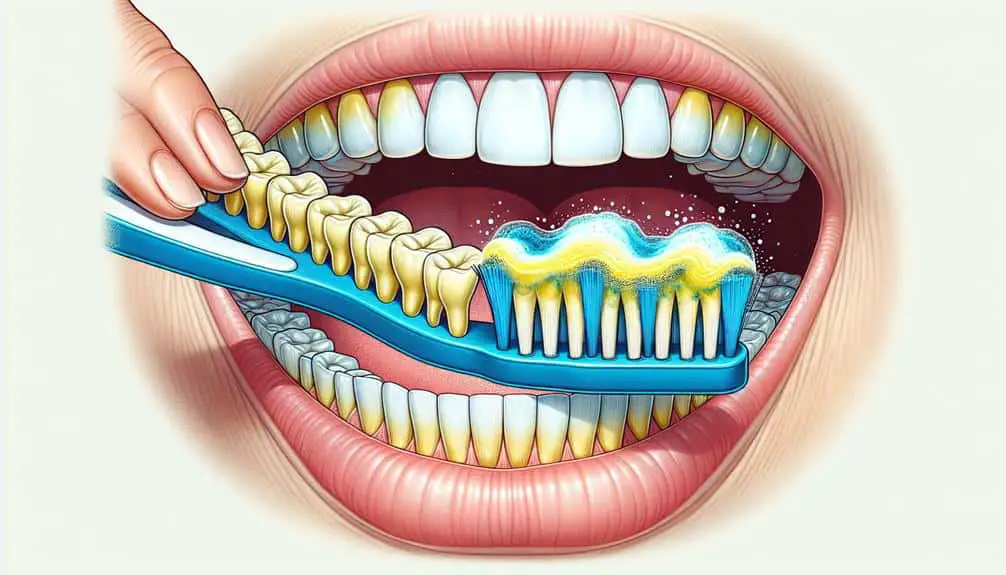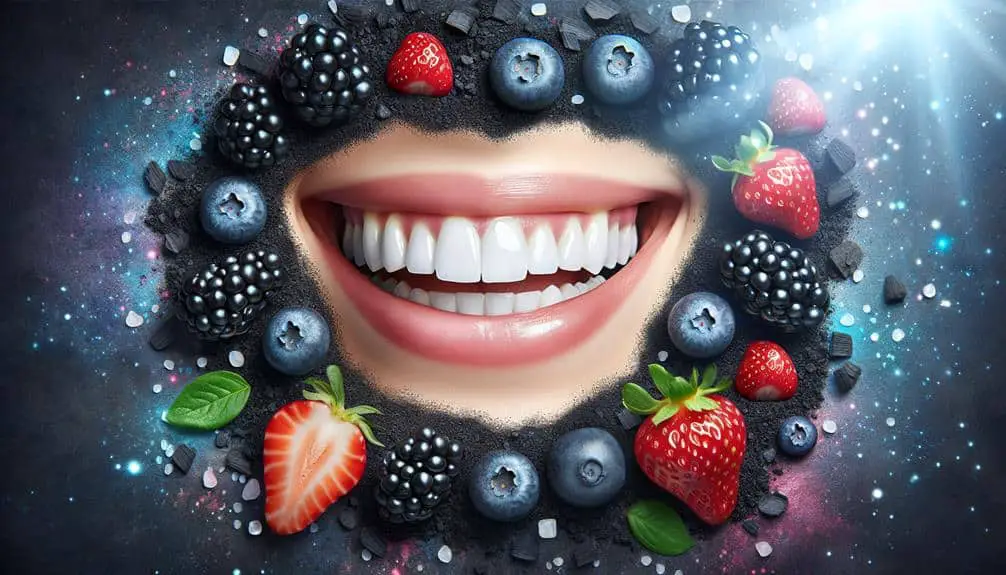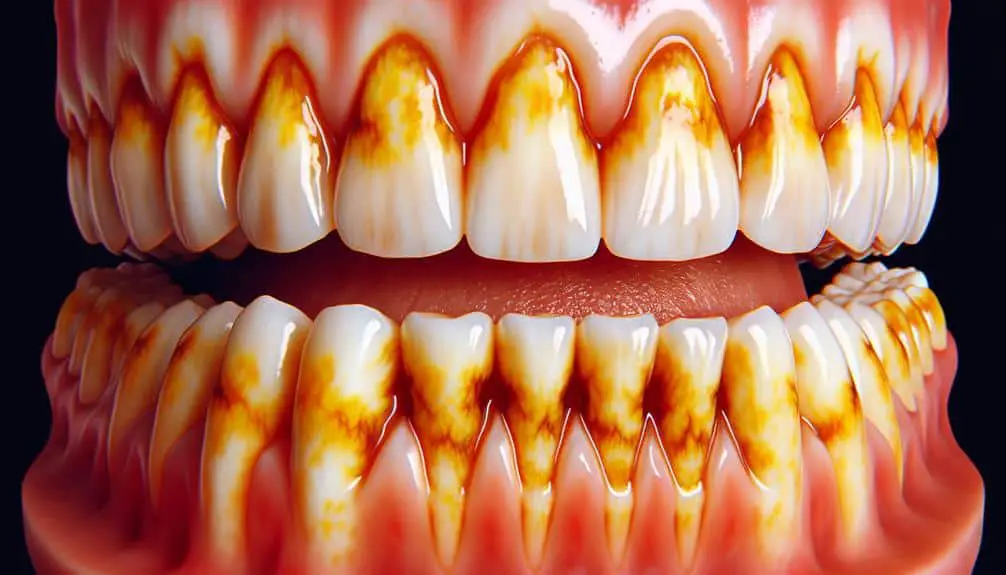Achieve a brighter smile with our top 10 solutions for fluoride stain whitening. Professional dental whitening and at-home kits, including whitening toothpaste, baking soda scrub, hydrogen peroxide rinse, activated charcoal paste, lemon juice treatment, strawberry rub, and apple cider vinegar rinse, offer effective ways to combat tooth discoloration and enhance oral health. Each solution targets stains with proven methods, ensuring a radiant smile. For further details on these diverse approaches to whitening, explore the full range of options available.
Key Points
- Professional whitening solutions like dental bleaching effectively remove fluoride stains.
- At-home kits with high whitening agent concentrations combat fluoride stains.
- Use whitening toothpaste with stain removal properties for daily fluoride stain prevention.
- Hydrogen peroxide rinse lifts fluoride stains and improves oral health.
- Natural remedies like activated charcoal safely remove fluoride stains from teeth.
Professional Dental Whitening
To effectively address fluoride stains, consider opting for professional dental whitening treatments. Dental bleaching, a common technique used in professional whitening, involves the application of a whitening agent like hydrogen peroxide to the teeth. This agent penetrates the enamel, breaking down stains and leaving your teeth looking brighter and whiter. Another effective method is laser whitening, which uses a specialized light to activate the whitening agent, accelerating the process and often producing immediate results.
Professional dental whitening treatments offer several advantages over at-home solutions. Initially, the concentration of whitening agents used in professional treatments is higher, leading to more effective stain removal. Additionally, the procedures are carried out under the supervision of trained professionals, ensuring safety and minimizing potential risks. Moreover, the results of professional whitening tend to be more consistent and longer-lasting compared to at-home kits.
When considering options for addressing fluoride stains, professional dental whitening, incorporating techniques like dental bleaching and laser whitening, stands out as a reliable and efficient choice.
At-Home Whitening Kits
When contemplating at-home whitening kits, it's vital to assess their effectiveness compared to professional treatments. Understanding the steps involved in the whitening procedure is key for achieving best results.
Make sure to follow the instructions diligently to maximize the advantages of using at-home whitening kits.
Kit Effectiveness Comparison
For a thorough assessment of at-home whitening kits' effectiveness, consider comparing the results achieved by different kits on fluoride stains. Stain removal and teeth whitening are paramount when evaluating the efficacy of these kits.
When comparing kits, look at factors such as the concentration of whitening agents, the inclusion of desensitizing agents, and the overall treatment duration. Some kits may offer faster results but could lead to increased sensitivity, while others may take longer but provide gentler whitening.
Additionally, consider user reviews and clinical studies to gauge the overall satisfaction and success rates with each kit. By carefully comparing these aspects, you can determine which at-home whitening kit is most effective for combating fluoride stains and achieving a brighter smile.
Whitening Procedure Steps
In the process of using at-home whitening kits, the first step typically involves preparing your teeth for the whitening treatment. Here are three important steps to follow for effective whitening:
- Pre-Treatment Options: Start by brushing and flossing your teeth to make sure they're clean and free of any debris that could interfere with the whitening process. Some kits may also include a pre-treatment solution to boost the whitening effects.
- Apply the Whitening Gel: Follow the kit instructions to apply the whitening gel evenly on your teeth using the provided applicator. Make sure to avoid applying the gel on your gums to prevent irritation.
- Post-Whitening Care: After the recommended time, rinse your mouth thoroughly to remove the gel. Avoid consuming staining foods or drinks immediately after whitening to maintain the results.
For long-term maintenance and expert recommendations, consult with your dentist for personalized advice.
Whitening Toothpaste
When choosing a whitening toothpaste, consider its effectiveness in removing fluoride stains and brightening your teeth.
These toothpastes are formulated to not only clean your teeth but also help in the removal of fluoride stains, leading to a brighter smile.
Look for ingredients that are known for their stain removal properties to maximize the whitening effects.
Brushing for Brightening
Consider incorporating a whitening toothpaste into your dental hygiene routine to help brighten fluoride stains on your teeth. Whitening toothpaste can be an effective tool in improving the appearance of your teeth by utilizing specific brightening techniques and aiding in stain removal.
Here are three key points to keep in mind:
- Abrasive Particles: Whitening toothpaste often contains abrasive particles that help in removing surface stains caused by fluoride, leading to a brighter smile.
- Whitening Agents: Look for toothpaste with whitening agents like hydrogen peroxide or carbamide peroxide, which can assist in breaking down stubborn stains.
- Regular Use: Consistent and regular use of whitening toothpaste, alongside proper brushing techniques, can gradually lighten fluoride stains and prevent new ones from forming.
Fluoride Removal Effectiveness
For enhanced effectiveness in removing fluoride stains, whitening toothpaste's formulation targets and breaks down stubborn discolorations using abrasive particles and whitening agents.
Whitening toothpaste can aid in fluoride stain prevention by gently scrubbing the teeth's surface, removing surface stains caused by fluoride.
While whitening toothpaste is effective, natural remedies can also assist in fluoride stain removal. Alternatives such as baking soda and hydrogen peroxide can be used in conjunction with whitening toothpaste to enhance the removal of fluoride stains.
The amalgamation of these methods can provide a holistic approach to combating fluoride stains and restoring the natural whiteness of your teeth. Remember to consult with your dentist for personalized recommendations based on your specific dental needs.
Baking Soda Scrub
To effectively remove fluoride stains and whiten your teeth, utilize a Baking Soda Scrub. Baking soda, or sodium bicarbonate, is a gentle abrasive that can help scrub away surface stains on your teeth. Here are three key points to take into account when using a Baking Soda Scrub for fluoride stain whitening:
- Best-suited Remedies: Baking soda is a natural remedy that can be used in DIY treatments to combat fluoride stains. Its mild abrasive properties make it effective in removing surface stains without causing damage to the enamel.
- Mild Scrubbing Action: When mixed with water to form a paste, baking soda can be used to gently scrub the teeth, helping to lift away fluoride stains and brighten the enamel. Remember not to scrub too vigorously to avoid damaging the enamel.
- Regular Usage: For ideal results, incorporate the Baking Soda Scrub into your oral care routine regularly. It's recommended to use this scrub 2-3 times a week to see improvements in fluoride stain removal and teeth whitening.
Hydrogen Peroxide Rinse
When whitening teeth to combat fluoride stains, incorporating a Hydrogen Peroxide Rinse can be a beneficial addition to your oral care routine. Hydrogen peroxide, a mild antiseptic and bleaching agent, has been used for years in dentistry due to its stain-removing properties. Its bubbling action helps lift stains off the teeth, making it an effective solution for combating fluoride stains.
The benefits of using hydrogen peroxide as a rinse extend beyond stain removal. It also acts as a disinfectant, killing bacteria in the mouth and promoting overall oral health. Regular use of hydrogen peroxide can help prevent future stains by keeping the teeth clean and free of bacteria that contribute to discoloration.
To incorporate hydrogen peroxide into your oral care routine, mix equal parts of 3% hydrogen peroxide and water. Swish the solution around in your mouth for 30 seconds to 1 minute, ensuring it reaches all areas of the teeth. Spit out the solution and rinse your mouth with water. It's crucial to use this rinse in moderation to prevent any potential side effects like irritation.
Oil Pulling
Consider incorporating oil pulling into your oral care routine as a natural method to help combat fluoride stains on your teeth. Oil pulling involves swishing oil around in your mouth to remove bacteria and promote oral health.
Here are some key points to guide you in understanding the benefits and techniques involved:
- Coconut Oil Technique: Coconut oil is a popular choice for oil pulling due to its antimicrobial properties. To use this method, take a tablespoon of coconut oil and swish it around in your mouth for about 15-20 minutes before spitting it out. This helps reduce bacteria that may contribute to staining and supports overall oral health.
- Oral Health Benefits: Oil pulling with coconut oil can help reduce plaque buildup, fight bad breath, and improve gum health. The oil effectively binds to the biofilm on your teeth, which may contain fluoride stains, and helps remove it through the swishing action.
- Sesame Oil Benefits, Morning Routine: Another oil commonly used for oil pulling is sesame oil. Incorporating this practice into your morning routine can be an invigorating way to start your day while promoting oral hygiene.
Activated Charcoal Paste
Utilize activated charcoal paste as a potent method for effectively removing fluoride stains from your teeth. Activated charcoal is a finely milled black powder made from natural substances like coconut shells. It's known for its excellent adsorption properties, which help in trapping toxins and chemicals. When used as a paste for oral care, activated charcoal can effectively bind to the fluoride deposits on your teeth, helping to lift them away.
One of the key benefits of using activated charcoal for teeth whitening is its ability to gently polish the enamel without causing damage. This natural remedy is considered safe and effective for removing stains caused by fluoride exposure. The charcoal particles work by adsorbing the stains and impurities, leaving your teeth looking brighter and cleaner.
Incorporating activated charcoal paste into your oral care routine can be a simple yet powerful way to address fluoride stains on your teeth. Its natural properties make it a popular choice for those seeking a gentle and effective solution for whitening their smile.
Lemon Juice Treatment
To effectively address fluoride stains on your teeth, consider incorporating a Lemon Juice Treatment into your oral care routine. Lemon juice is known for its natural bleaching properties that can help combat tooth discoloration caused by fluoride stains. Here are some key points to keep in mind when using this treatment:
- Citrus Application: The citric acid in lemon juice acts as a natural bleaching agent, helping to lighten stains on the teeth. When applied correctly, it can contribute to a brighter smile by reducing the appearance of fluoride discoloration.
- Acidic Treatments: Lemon juice falls into the category of acidic treatments, which should be used cautiously. While the acid can help whiten teeth, excessive use may erode the enamel, leading to sensitivity and other dental issues. To safeguard your enamel, it's crucial to moderate the frequency of lemon juice application.
- Enamel Protection: To safeguard your enamel while benefiting from the whitening effects of lemon juice, consider rinsing your mouth thoroughly with water after treatment. This can help remove residual acid and minimize potential damage, ensuring your enamel remains strong and healthy.
Strawberry Rub
As you explore ways to address fluoride stains on your teeth, the efficacy of using a Strawberry Rub treatment can be considered. Strawberries contain fruit acids that can help in whitening teeth and reducing the appearance of stains. These fruit acids work by breaking down the compounds that cause the stains, allowing for a brighter smile.
Strawberries are often used in natural remedies for teeth whitening due to their gentle yet effective nature. To create a Strawberry Rub, mash up a ripe strawberry and apply it directly to your teeth. Gently rub the strawberry on your teeth for a few minutes, ensuring that all surfaces are covered. Leave the mixture on for about five minutes to allow the fruit acids to work their magic.
Afterward, thoroughly rinse your mouth to remove the strawberry residue. While this method may take some time to show significant results, consistent use can help diminish fluoride stains and enhance the overall appearance of your teeth.
Apple Cider Vinegar Rinse
Consider incorporating an Apple Cider Vinegar Rinse into your oral care routine to help combat fluoride stains on your teeth. Apple cider vinegar is known for its acidic properties, which can aid in restoring the ideal pH balance in your mouth and reducing the appearance of stains caused by fluoride. Here are three key benefits of using an Apple Cider Vinegar Rinse as part of your dental hygiene regimen:
- pH Balance: Apple cider vinegar helps maintain the perfect pH level in your mouth, creating an environment less conducive to the formation of stains on your teeth.
- Natural Remedies: By opting for natural remedies like apple cider vinegar, you can avoid harsh chemicals often present in commercial whitening products. This natural approach can be gentler on your teeth while still effectively combating fluoride stains.
- Antibacterial Properties: Apple cider vinegar possesses antibacterial properties that can help in reducing plaque buildup and keeping your mouth healthy. This can contribute to overall oral hygiene and aid in preventing future staining.
Frequently Asked Questions
Can Fluoride Stains Be Completely Removed With Any of These Whitening Solutions?
You know, tackling fluoride stains is like polishing a diamond—requires patience and precision. Some whitening solutions can effectively remove stains, but long-term results depend on maintenance. Consistent use is key for lasting brightness.
Are There Any Potential Side Effects or Risks Associated With Using These Whitening Methods for Fluoride Stains?
When considering whitening methods for fluoride stains, be aware of potential risks like tooth sensitivity and gum irritation. Safety measures include following instructions carefully and consulting a dentist. Long term effects may vary, and alternative treatments should be explored.
How Long Does It Typically Take to See Results When Using These Whitening Solutions for Fluoride Stains?
As you commence on the journey of whitening fluoride stains, anticipate a treatment duration of several weeks. Manage expectations by tracking progress diligently. Stain persistence varies, but consistent use of solutions yields visible results over time.
Are There Any Specific Recommendations for Maintaining the Results of Whitening Treatments for Fluoride Stains?
To maintain the results of fluoride stain whitening treatments long term, follow these maintenance tips. Implement a preventive care routine, including regular brushing with fluoride toothpaste, flossing, and using whitening products as recommended. Consistent aftercare helps sustain your bright smile.
Can These Whitening Solutions Be Used for Children or Individuals With Sensitive Teeth?
For children's whitening, safe options are vital for sensitive teeth. Guarantee whitening solutions designed for kids or those with sensitivity. Look for gentle formulations and consult a dentist for appropriate recommendations tailored to individual needs.



